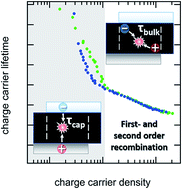Unravelling steady-state bulk recombination dynamics in thick efficient vacuum-deposited perovskite solar cells by transient methods†
Abstract
Accurately identifying and understanding the dominant charge carrier recombination mechanism in perovskite solar cells are of crucial importance for further improvements of this already promising photovoltaic technology. Both optical and electrical transient methods have previously been employed to strive for this warranted goal. However, electrical techniques can be strongly influenced by the capacitive response of the device which hides the carrier recombination dynamics that are relevant under steady state conditions. To ascertain the identification of steady state relevant charge carrier dynamics, it is beneficial to evaluate thicker films to minimize the impact of device capacitance. Herein, the electrical transient response in very efficient planar co-evaporated n–i–p solar cells is studied by varying the active layer thickness from 500 nm to 820 nm and is compared to a solution-processed perovskite device with an active layer of 350 nm thickness. In the case of the n–i–p devices, the capacitance of the 500 nm solar cell leads to longer perceived decay times in the lower voltage regime, while in the higher voltage regime quite similar kinetics independent of the active layer thickness are observed, allowing us to identify the transition from capacitance-affected to the sought-after bulk charge carrier dynamics. We show that increasing the perovskite thickness by more than 50% does not affect the recombination dynamics significantly, confirming the high quality of the vacuum-processed perovskite solar cells. Finally, it is demonstrated for the first time for perovskite solar cells that the recombination order in both thicker devices ranges between 1.6 and 2, pointing towards trap-assisted and free-carrier recombination under operating conditions. We emphasize that the observed low recombination orders are in strong contrast to earlier literature as well as to the thinner solution-processed device, which suffers from both shorter carrier lifetimes and a larger device capacitance.



 Please wait while we load your content...
Please wait while we load your content...